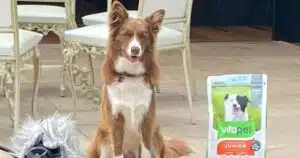
The significance of water as a nutrient for our pets and the role of moisture in dog food is often forgotten.
Despite not being commonly acknowledged as such, water is indispensable for enabling our pets’ bodies to function optimally in almost every aspect.
They need to consume a certain amount of water (or moisture) to properly digest their food. If moisture isn’t consumed with the food itself, the body must supply its own moisture by drawing it out from its tissues. As you can imagine, this can compromise the tissue function and cause stress to important organs such as the liver and kidneys, which is why moisture in dog food is so important.
Water is sent to the digestive tract to help facilitate the digestion of every meal and some pets will drink large volumes of water after their meals to try to rehydrate. This is more common in kibble-based diets that are low in moisture and high in carbohydrates, than moisture-rich fresh food diets.
If our pets are unable to access adequate water, or their body isn’t functioning efficiently, they may develop constipation, dehydration, or other health problems.
Many holistic vets believe many pets that are fed kibble-based diets suffer from chronic, low-grade dehydration. This dehydration can give them a tell-tale bloated look, caused by fluid retention in the body’s tissues as it tries to hold onto as much fluid as possible because it knows it’s not receiving enough fluid from the continuous cycle of dry meals.
In humans, studies have shown that chronic low-grade dehydration can lead to problems with digestion, defaecation, urination, kidney function, respiration, skin, blood pressure, cholesterol, joints, and pH balance. It is likely that our pets would suffer similar problems.
In general, it is recommended to provide three times the volume of water as the food when feeding dry food. For example, if feeding 100g of kibble, ensure there is at least 300mL of water available. To compensate for the lack of moisture in the kibble, many dogs gulp down large amounts of water to moisten the meal and ease digestion.
However, although it is necessary to obtain the moisture, the large intake can place undue stress on the organs, (especially if the dog is suffering with age related or congenital problems). Those organs may already be struggling to cope with a rendered diet of difficult-to-assimilate proteins and manufactured nutrients.
Furthermore, if you’ve ever seen what happens to kibble when they encounter moisture, you’ll know that they can swell to several times their original size. When this happens in the gastrointestinal tract, it can increase the risk of bloat or gastric torsion in dogs prone to these disorders, not to mention just general discomfort. This causes a potentially fatal medical emergency, especially for larger, barrel-chested breeds.
Note that the exact link between kibble and bloat is not clear cut, but it is clear a sudden swelling of stomach contents is less than ideal. In contrast, foods that contain sufficient moisture don’t swell up in the stomach. This may make a high moisture diet better suited for bloat prone breeds.
Moisture in dog food is also important for bladder and kidney health. There’s nothing worse than dry food for a dog prone to urinary tract infections, crystals or stones, and many holistic vets link long-term feeding of kibble to the increasing prevalence of urinary and kidney disorders in dogs (and especially cats).
Moisture rich food helps prevent chronic dehydration, so it’s beneficial for pets prone to urinary tract infections, blockages and even kidney problems. It’s common sense that a higher moisture diet will help promote and maintain overall urinary tract and kidney health.
One of the most logical arguments for a moisture rich diet is that it more closely resembles their ancestral diet, or what they would be eating if they were in the wild. A dog’s natural diet which would be meat, organs, fruit, and vegetables contains about 70% water (note bones are about 30% water). Kibble normally contains 10% or less moisture. The more a diet strays from ideal or what nature intended, the more likely it will be to put extra pressure on the body to perform at its best.
Most holistic vets recommend a diet as close as possible to its natural state to optimise digestion and nutrient absorption. Ideally, kibble should be eliminated completely, especially for pets prone to health problems caused by lack of dietary moisture. Not every pet family will find this possible, so ensuring that there is adequate water available allows pets to obtain the moisture as needed. Cats can be particularly fussy with water bowls so investing in a water fountain can be beneficial.
It is also important to note that older pets, especially those with arthritis and dementia often won’t access water as often or as easily as needed so owners need to remember this, and therefore moisture rich foods are particularly important. Many pet households will provide ‘mix’ feeding for their pets.
This is where they offer kibble as well as some fresher, less processed, wet foods, or even healthy table scraps or home cooked meals served along with the kibble or in place of just one kibble meal each day. This can go a long way to improving the moisture content of their diet and an alternative if the fresh food diets are cost prohibitive.
Cost and convenience are generally the two big drivers for pet parents to choose a kibble-based diet over fresh or moisture rich diet. For convenience there are good quality dehydrated and freeze-dried foods on the market that you can add water to ‘rehydrate’ before feeding.
A cheaper moisture rich food that is popular is tinned food, however, tinned or canned food, whilst being moisture rich, is not equivalent in quality to a fresh food diet, as it is highly processed and far from what nature intended. Not all moisture in dog food is equal!
It is also worth considering that investing in more natural diets will likely result in lower long term vet bills, after all, they are what they eat – just like us.
Dr. Nicole Rous is a holistic veterinarian and the founder of Shy Tiger, an Australian owned pet care company. With a passion for natural and holistic health practices, she operates Mont Albert Veterinary Surgery in Melbourne, providing modern, professional and affordable health care for pets. More at Shy Tiger and Mont Albert Vet.

Chronic Kidney Disease in dogs






Get your paws on Lara Shannon’s best selling books ‘Eat, Play, Love (your dog) and World of Dogs.
Available in Australia, USA, UK and Canada.